Don't Drown....Don't Be A Follower!
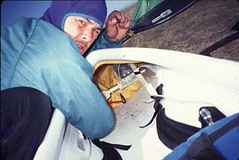 Kayaker solo in the Inuit Passage,
Kayaker solo in the Inuit Passage,
2500 miles, 50 paddle-days,
Self contained / self responsible...
across the top of the continent.
IMHOSafety systems have been, always will be a matter of personal preference...they should be...with varying equipment, conditions, skill levels, the situational time and place... everyone needs to be designing their 'fall-back' 'retreat' and
'ESR - emergency self response' systems to best serve their own needs (read: to save their own ass).
I agree with Hunt's Johnsen's thread / trend of thought in previous discussions on helmets...paraphrased as
"don't tell me how to keep myself safe...it insults my intelligence"...granted, some people AREN'T smart enought to take care of themselves in any situation...in general, other organizations (BCU ACA USCG...definitely not state govt.) shouldn't be determining what is SAFE for you...you should.
PFD thread boatertalk: http://boatertalk.com/forum/SurfZone/758631Those who rely on the 'others' and other 'associations' to develop their safety systems are the ones I have found washed-up on the beach here in Alaska (and they are not always breathing).

ACA certifiedDon't be a 'follower' when it comes to your own safety.________________________
Personal Safety Response / PhilosophyKayakers have been d
eveloping their own 'safe ocean systems' for millennia...I can guarantee this kayaker wasn't ACA safety certified or USCG approved ...yet it's obvious he's thought through 'how to stay alive' on the ocean [note: flotation device, food procurement tools, safety paddle/accessories, sled for alternative transport...also, I can attest to his survival 'cause I work with this paddler's also v.competent offspring today]
![ct20015r[1]](http://photos4.flickr.com/5198507_9322f064fa_m.jpg) Nunivak Island kayak and safety gear...circa 1900
Nunivak Island kayak and safety gear...circa 1900Some Generalities
Here in Alaska we have separate outfitting and safety regimes built for the many scenarios we surf...they all have different technical and situational responses depending on the objective dangers...paddlers just need to be:
thinking through' worst case scenarios'...evaluating their own competencies, be inclusive (relate to ALL the variables - including your buddies level of expertise / LOE) and develop a 'best response'.
narrowing the objective dangers...beariing in mind any response compromises and address the compromise-slack via your ultimate strong points...there are 'always' compromises when you're on the ocean!
[Some of the safest paddlers I've surfed with have been serious high altitude mountaineers and big wall climbers because they've already attained the 'thought process' and can think through 'worst-case scenarios' with ease and precision.]
All safety requirements vary; therefore your technical and philsophical response should as well.
Kit for extended ocean travel,
Arctic Ocean environ,
solo.
i.e. Gulf of Alaska - near town...is much different than solo outer reef in the Gulf ...is much different than a Bering Sea self contained surf safari expedition...so are the safety scenarios.
Get proper on and off-the-water training, some examples:
http://www.towsurfer.com/rescue.asphttp://www.wildmed.com/courses.htmlSmart surfers won't be tied to rigid organizational standards for 'surfing' or someone else’s response to what is 'safe'. Use your brain and all the resources you can get your hands on!
___________________
Personal Safety Response / Technical
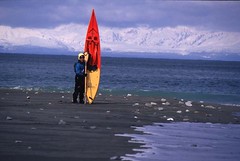
RE: PFDs...
Wearing a PDF doesn't always = safe
There are obvious times when it becomes a hindrance...i.e. when you're trying to swim, inside-outside, in heavy conditions.
[Disclaimer...I personally don't surf decked kayaks in
heavy conditions, not because I dislike decked kayaks or any other reason, it is for safety reasons alone. Qualify heavy? North-shore Hawaiian Islands / winter, Outer-reef Gulf of Alaska / fall and spring. I surf ‘boats’ that enable safe ocean transit... for ME it's hybrid skis and custom designed / constructed wash deck 'boats'. My boat doesn't swamp, has inherant floatation, is leashed and is THE critical safety element for offshore work and outer-reef surfing in Alaska...I swim with my equipment, often carry a small flipper as swim back-up and enjoy all of the technical and social response capability and ocean surf nuances / conditions that competent board surfers do. I often-times carry extra flotation on=board and rarely wear a PFD]
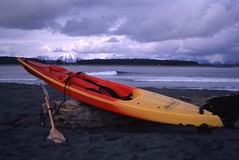 http://www.huntjohnsendesigns.com
http://www.huntjohnsendesigns.comIn
Alaska we're usually in drysuits that have as much inherent buoyancy as you want (burp them to adjust how much air / floatation you want to expel or retain).
We've been using swim vests from time to time when conditions warrant...the simplest is a
'racer' style bib that facilitates entry into the flotation compartments via velcro opening so that flotation (bubble-wrap / sheet mini-cell foam) can be added or subtracted...buoyancy can be varied as needed. Racers have been doing this for at least ~ 20 years. I've made my own...
I know that there are others…but Dana Chladek, Rapidstyle may still lay them up as the Rapidfloat PFD…they are excellent:
Click into Dana's Rapidsyle site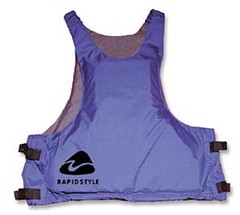
I've recently used a NRS product
'Anti Gravity Shirt' under my drysuit for increasing buoyancy and as 'backup' if my suit blows-out in a heavy wipe-out (never happened, but could, there's that WCS). They’re pretty-good…if the floatation was 'interchangeable...the shirt would be excellent:
http://www.nrsweb.com/shop/product.asp?pfid=2244&deptid=942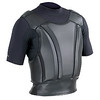
We’ve used
inflatable devices as ‘backup’ in the surf and for offshore work for a long time / a belt packed inflatable collar is a very good backup in an emergency and has been especially useful in HI...here’s one we have:
Sterns makes a few:
http://www.marsars.com/cg140001.htmlThese are excellent and can be stored in a fanny pack :
http://www.marsars.com/it050011.html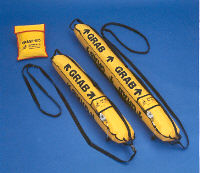

Astral Buoyancy has been pretty progressive with theirswim aids lately...this year they are promoting a 'Hybrid' swim vest that allows for variable flotation via an inflatable bladder; 8 to 25 lbs...we'll be trying it...looks promising:
http://www.astralbuoyancy.com/lowband/5hy.html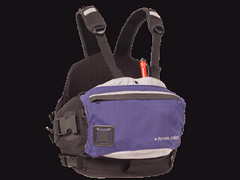
__________________
Smart surfers won't be tied to rigid organizational standards for 'surfing' or someone else’s response to what is 'safe'. Develop your own personal ESR system.
Good luck
ML
Martin's 'qayaq_alaska' posts on boatertalk.com
Boatertalk is definately the best site for a 'virtual conversation' with other paddle-surfers.
Many of my personal posts are threads regarding competition and classification schemes, Alaska as a paddle-surfing venure, design and safety.
link here to read qayaq_alaska archives
Some of the discussion centers around important doctrine 'a few' have been preaching all along, at least ~last 10 years: open open open (can you say it any other way!) competition, national and international qualify'ers at quality venues during quality surf, adequate waiting periods for high level comps., quality judging based on surf sport criteria, etc. etc.
[I admit to not being very active...the site is somewhat stagnant, as is the sport...IMHO relegated to self proclaimed and un-neccessary regulation of a surfing sport, chasing the 'elusive' decked waveski design equivalent, eliminating the evenpar competition for non-decked surfers, creating rules around anal-retentive-design-criteria, lack of inclusion strategy for newbies to the sport, and more...
....and granted there are some who have supported common-sense competitive environs and done something about it... but really, way way too slow to change...AND, I'm way off the beater track with way too many virgin spots to visit to really be able to support any 'real' change (or to really give a true rats ass ) ;-)
here're some creative thinkers I read:
byrondesign search
makomike search
izzy search
hjdww search
corran
Not sure how many posts I've had... but here's a complelation of some:
link here to read qayaq_alaska archives
There's been lots of discussion regarding the potential for Alaska to host a World Championship Event.
This post initiates a discussion on BoaterTalk...here:
On Boatertalk
http://boatertalk.com/forum/SurfZone/655312KawakaSki writes:
"Second, how sure are you about the surf in Alaska? Martin sounds like quite the character but it seems to me he could sell iceboxes to Eskimos. There are surely some days where the surf is great but how long do you have to wait for these conditons. It seems hard to believe there would be enough good days of swell combined with acceptable local conditons for a multi-day contest. I’d compare this to finding good surf days on our windward coasts – few and far between!"
Martin's reply:
http://boatertalk.com/forum/SurfZone/657160David...your comments on Alaska surf conditions are pure conjecture...you really need to study your weather charts more closely and the 'lay of the land' of our North Pacific / Gulf of Alaska Coastline - which alone totals ~3-4 thousand miles of open ocean (the majority of which I've traveled, surfed and scouted via kayak). Your statements are way off and simply not true!
While the seasons may be a little shorter (governed only by one's abilty to withstand colder conditions and easily remedied with a drysuit) ...the average consistency, surfable conditions and wave heights rival, and depending on the year - surpass Hawai'i and Cali...don't take my word for it...research and read the data David...current and archived wind and wave charts are available on the .net !
http://www.buoyweather.com/http://www.oceanweather.com/data/Folks have been commenting for years that...no matter where the venue...quality conditions will only come to surfers and competition organizers who can WAIT...Nationals and Worlds should ALWAYS take place over extended waiting periods when and where the best conditions can be surfed and judged...the 'weekend warrior' approach will always be 'hit or miss'...there-in lies the real problem!
Fact ...many of the best surfers in the world, including Hawaiians, have been coming North for years - you won;t hear or read much about it (albeit the occasional surfer 'rag' article) as they're smart enough to keep the real treasures to themselves.
In regards to marketing...you're connotations are well taken...and it IS going to take 'major' marketing efforts to bring the US Surf Kayak scene out of it's current state...can you say stagnant...I've got to agree with Byron - relatively speaking - the scene IS 'dead'. If it wasn't for a couple vibrant video features, clips and a few 'new boat' promotions (and boatertalk of course)...we wouldn't hear squat. Look at the US coverage of the last Worlds...pitiful!
I can tell you that Alaska can be, and always has been, a major attraction for every major media outlet in the US when it comes to alternative sport. As Izzy notes...it's a perfect fit given the kayak history here, the quality of the surf and novelty of the setting! I continue to say...."Alaska can put on a tremendous, world class event ...quality surf, world-wide exposure, tremendous side trips for the participants"...when the time is right! Anyone who wants details on our management team, surf venues or any details is invited to come up and do what it takes to get comfortable with the scene here!
Allow me the liberty to rub the 'awesome Alaska' in a little more...not only do we have the coastline...we've got the islands too ...ooooooh!
http://users.erols.com/jcalder/USLARGESTV1.htmlBTW...I just returned from a solo circumnavigation of an Island in the North Pacific, about 3 times the size of O'ahu, with virgin breaks from horizon to horizon...didn't see another human for 10 days...only me and the seals in the line-up...sorry brah! ;-}
Tongue in cheek David...just want to keep the 'Worlds' ball rolling for Alaska...nothing personal...
;-)
Cheers,
Martin
PS...Hunt...FYI...oceanographers tracking north pacific gyre currents this year noted water temps of 65df + in the Gulf of Alaska...there has also been significantly more bycatch of warm water species of fish in Alaskan waters this year...who knows...BTW...nice Wave Witch web page!
Aloooooha
__________________________________________________
This is a comment I wrote on boatertalk fall '03 following a post that indicated Alaska was ready to consider hosting an international event:
Want a five-star event...consider us in Alaska.
5257. Next Worlds...well, how'a bout Alaska! by qayaq_alaska Sep 26 2003, 0:56 GMT
Martin, are you going to organize and host the event?........ by jonostevens Sep 26 2003,
Jono...
Absolutely
While my personal expertise is wilderness and remote field logistics (not to mention having paddled over/~ 10,000 miles of coastline in this Northland ;-} ) I have no reservations about taking the lead as we have quite the crew assembled already! From host community participation to national transportation specialists to local five star wilderness resorts!
FYI...WE've done it before (incl. paddle-surf events, whitewater races, huge film and TV jobs, world-class ski and climbing events, seakayak symposiums) ...the teams and key support are already on-line. WE also have a core of volunteers ready to help...most are from affiliations with outdoor centers and university programs we work with...we can assemble any / all of the critical and neccessary 'grunt' support.
WE have the ways and means of publicizing the event like never before...which means > event sponosorship > direct support for athletes, > quality of service for attendees at less the cost .
Most importantly, our surf events are in small remote communities (500 - 1000 people) where participation at the core community level is the key to success...we have that! Red carpet!
Not to mention the five-star wilderness lodge complete with full service landing craft, heliocopter, filxed wing on floats....AK King Crab, Salmon and Alaskan Amber every night!
you getting the idea!
Want a five-star event...consider us in Alaska.
I do agree...this type of event does takes huge planning, time and effort, especially given the remote nature of our potential venues.
...we're officially putting our name in the hat!
ML
Some initial information on Paddle-surf competitions in Alaska
...appeared in 'Canoe and Kayak' Magazine and was subsequently picked up by organizations like the Knik Canoe and Kayakers, an Anchorage based club promoting kayaking in Alaska.
http://www.kck.org/articles/articles/yakutat.htmlAlaskans 'Lining-Up'
by Martin Leonard, photos by Spinnaker, courtesy Hunt Johnsen Designs WaveWitch, Honolulu Hawaii
Paddlers in Alaska are 'lining up, or better said, the waves are lining up and Alaskan kayak surfers are 'on it'.
This past spring, over 20 professional paddlers, guides and paddle surfing enthusiasts gathered in the Tlingit Indian village of Yakutat, located in the central Gulf of Alaska, to celebrate the first Great Alaska Kayak Surf Rendezvous.
With over 35,000 miles of some of the most remote coastal tideline in the world and 1000's of miles of open-ocean surfing breaks to chose from, Alaskan paddlers have allot to be excited about!
Martin Leonard III, a professional paddler and veteran seakayaker and surfer who has paddled some 10,000 miles of Northland coastline elaborates, "we have world class surf breaks all over Alaska. I've charted 100's of potential sites, but one our big obstacles is accessibility....with no roads every trip becomes and expedition surf safari. Currently our surfers have organized formal initiatives around two very unique and accessible sites in the open ocean, central and western Gulf of Alaska - Yakutat and Kodiak Island."
With the increase in world-wide acceptance and participation in the sport of kayak surfing, Alaskans anticipate Yakutat and Kodiak to develop into world class events. "Right now our efforts are on getting our surfing venues wired and in working with our Hawaiian counterparts to develop strong team efforts and professionalism in regards to competition. We'll be soliciting for world-wide participation in Alaska very soon because we're seeing an broad interest with initial contacts from northern surfing communities in Europe and others with a natural affinity for 'cold water'!
Alaskans are adamant about promoting the 'surfer first' perspective by teaming up on educational and training efforts with their board riding counterparts. "No way we're going to proliferate the board vs kayak surfer attitudes you find in the lower 48" states Leonard, "we're joining with the Association of Surfing Professionals (ASP is the world governing body for surfing and competitions) and the local board surfing communities to proliferate the sport from the ground up....any new surfer is a 'grommet' and must learn the priorities and etiquette as a 'surfer first'."
"We're taking lessons learned form the pro board surfers and avoiding the pitfalls" states Spinnaker Wyss-Johnsen. Spin is a Hawaiian residing in Alaska, a trophy winner at the Costa Rica worlds, and a WaveWitch team rider for Hunt Johnsen Designs in Hawai'i. She notes "we're initiating the competition scene here in Alaska in extremely challenging, high quality surf which will improve the standard of paddle surfing immediately. We're also bringing top level kayak surfing craft into the state and making them available to all of our participants. We're trying not to limit the competition scene by creating sense-less and arbitrary class limitations while promoting both limited and 'truly'open competition without burdening the system. Everyone will have the opportunity to kayak high quality waves and to compete in or on the craft of their choice".
For more information on surfing in Alaska check Martin's
Qayaq's Alaska website
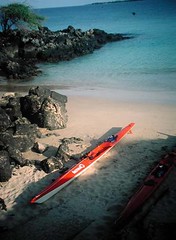
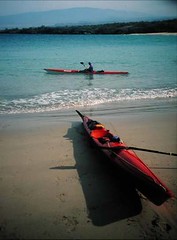
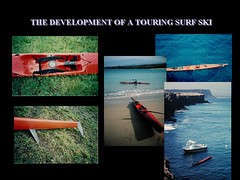
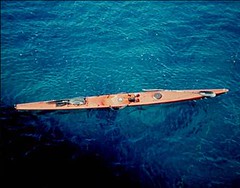
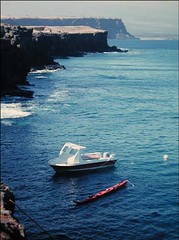
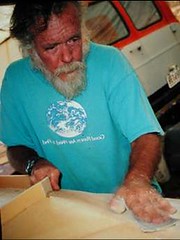

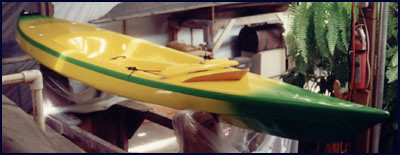
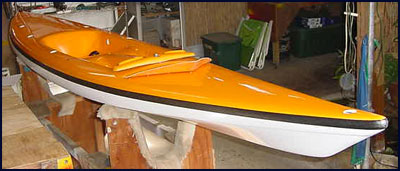

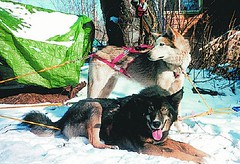
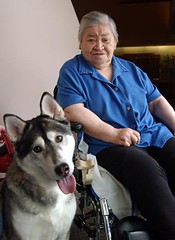
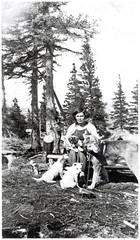



![ct20015r[1]](http://photos4.flickr.com/5198507_9322f064fa_m.jpg)






